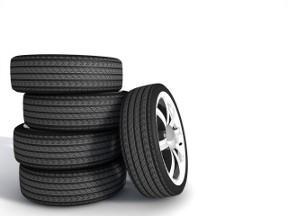What’s the most important car part to ensure safety? Seat belts? Airbags? Regular maintenance?
Of course, you could argue for many different components. Thousands of parts work together to create the safest driving experience possible.
But since we’re heading into winter, let’s talk about one of the most crucial aspects of road safety, something we rarely pay close attention to: tire tread depth. Your tires are the only part of your car that actually makes contact with the road, and the quality of that contact is determined by your tire tread.
Tire tread depth impacts your car’s traction, handling, and stopping power, especially in adverse weather conditions. (Like Colorado winters!) Over time, tread wears down, which reduces its ability to grip the road and keep you safe. Is your tire tread safe? Let’s learn more.
Why Tire Tread Depth Is Important for Safety
Tire tread is the rubber on the circumference of a tire that makes contact with the road. It’s that ribbed pattern on a tire’s surface, designed to “hug” the road in different road conditions. It moves water, snow, mud, and other debris out of the tire’s grooves, giving your vehicle more traction and increased safety.
Tread depth is simply the measurement of the grooves on your tires. Grooves make traction possible. They help the tires and your vehicle “stick” to the road. Without tread, you would have a smooth surface that simply glides across the road. Not good for safety. You need tread depth for:
Improved Traction
The tread on your tires helps them grip the road. When tread depth is too shallow, your tires lose traction, which increases your risk of skidding or sliding. Proper traction is particularly important when you’re driving in rain, snow, or ice, as it helps prevent hydroplaning.
Better Stopping Power
Tires with sufficient tread depth can stop more quickly and effectively. When your tread is worn, your car needs a longer distance to come to a complete stop, especially on wet or slippery surfaces. This increases the risk of rear-end collisions or other accidents when you need to brake suddenly.
Enhanced Stability and Handling
Good tread depth helps your tires maintain better contact with the road, giving you more control over steering and handling. Shallow tread reduces stability, making your car feel less responsive, particularly at higher speeds or around corners.
Resistance to Hydroplaning
The grooves in your tire tread channel water away from the tire, which helps prevent hydroplaning. Shallow tread can’t disperse water as effectively, increasing the risk of losing control in wet conditions.
How to Check Your Tire Tread Depth
How do you know if your tire tread depth is adequate? Luckily, it’s fairly easy to check. You don’t need specialized tools to do it, and you can do it quickly when you have a few minutes to spare.
The Penny Test
Have a penny in your pocket? Perform a tread test in seconds. Here’s how.
Take a penny and insert it into the tread groove with Lincoln’s head facing down.
If you can see the top of Lincoln’s head, your tread is 2/32 of an inch or less, which means it’s time to replace your tires.
If part of Lincoln’s head is covered, your tread depth is likely still safe. Just keep an eye on it.
Using a Tread Depth Gauge
Want a more precise measurement? You can use a tread depth gauge. These tools are inexpensive and can give you an accurate reading of your tire’s tread depth.
Insert the gauge into a tread groove and press until it reaches the bottom. The gauge will display a reading, typically in 32nds of an inch. If your tread is at or below 2/32 of an inch, it’s time to replace your tires.
Built-In Tread Wear Indicators
Many modern tires have built-in tread wear indicators—small raised bars that run across the grooves. These indicators provide a convenient visual cue that it’s time to replace your tires. When your tread wears down to the level of these bars, it’s time to consider new tires.
How Often Should You Check Your Tread Depth?
Depending on the tires you purchase, you can expect the estimated lifespan to be 50,000 to 75,000 miles or so. Of course, that depends on many different things, such as road conditions, how aggressively you drive your vehicle, and heavy loads.
So tire tread depth isn’t something you need to check daily, but making it part of your routine can help you stay on top of tire health.
Checking your tread depth once a month is a good habit, especially if you drive frequently or in challenging road conditions.
If you’re planning a road trip, it’s a smart idea to check your tread depth to ensure your tires are road-ready.
As the weather changes, tread depth becomes more critical. In winter, deeper tread is better for handling snow and ice, while summer driving also requires adequate tread for handling heat and rain.
When to Replace Your Tires
Even with regular care, tire tread wears down over time. It’s the price of owning a vehicle. Here are some things to watch for:
Tread Depth Is Below 2/32 of an Inch
The 2/32-inch rule is the guideline, but it’s often safer to replace your tires before reaching this limit, especially if you frequently drive in wet or snowy conditions. When you place new tires on your car, the tread depth typically ranges 10/32 or 11/32-inch. Anything above 6/32 is generally considered good tire depth. Many experts recommend replacing tires at 4/32 of an inch to maintain optimal safety.
Uneven Tread Wear
If one section of your tire wears down faster than the others, it could be a sign of misalignment or suspension issues. You can sometimes see this with a quick check. Uneven tread can reduce traction and compromise handling, so it’s best to replace tires with significant uneven wear.
Cracks, Bulges, or Cuts
Physical damage to your tires, such as cracks, cuts, or bulges, can weaken their structure and increase the risk of blowouts. If you notice any of these signs, it’s time to replace your tires to ensure safe driving.
Frequent Loss of Air Pressure
If you find yourself constantly refilling your tires, it could indicate a slow leak or general wear that affects their ability to hold air. Persistent air loss can be a sign that replacement is needed.
Tips to Preserve Tire Tread for Longer Life
Ready to purchase new tires? You want the longest lifespan possible, right? Here’s how to make that possible.
Maintain Proper Tire Pressure
Underinflated or overinflated tires can lead to uneven wear. Check your tire pressure monthly and keep it within the manufacturer’s recommended range to ensure even tread wear and extend tire life.
Rotate Tires Regularly
Rotating your tires every 6,000 to 8,000 miles helps ensure even wear across all four tires, which maximizes tread life and keeps your car balanced on the road.
Align and Balance Tires
Misaligned or unbalanced tires can lead to uneven tread wear and cause your car to pull to one side. Regular alignments and balancing prevent this, giving your tires a longer lifespan.
Avoid Hard Stops and Accelerations
Fast acceleration and sudden stops put extra stress on your tires, leading to faster wear. Drive smoothly and avoid aggressive maneuvers to keep your tread intact.
Keep Tires Clean
Dirt, grime, and chemicals from the road can break down rubber over time. Regularly washing your tires can help protect them and reduce the buildup of damaging substances.
The Cost of Ignoring Tread Depth
Have you ignored tire tread depth in the past? It isn’t just a risk to your safety.
Poor tread depth increases your chances of skidding or hydroplaning, which can lead to accidents. Tires with uneven or low tread wear unevenly, which can lower fuel efficiency and increase your gas costs. Driving on worn tires can damage your suspension and alignment, leading to expensive repairs down the line.
If you’re unsure about your tire tread or suspect it’s time for a replacement, bring your car to us. Our team of experts can inspect your tires, recommend the best options for replacement, and provide tips on how to keep them in top shape. Schedule an appointment today, and drive with confidence, knowing your tires are road-ready and safe!



